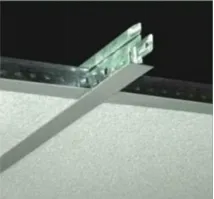Feb . 18, 2025 04:51 Back to list
difference between gypsum and pvc ceiling
Ceilings are an essential component in the physical and aesthetic design of interior spaces. Among the many materials available for ceiling construction, gypsum and PVC (Polyvinyl Chloride) are two of the most debated choices. Both materials offer distinct features that cater to different requirements, presenting unique benefits and challenges to homeowners, architects, and contractors. Here we delve into the differences between gypsum and PVC ceilings, offering an expert analysis that considers practicality, aesthetics, cost, and durability.
In terms of aesthetics, PVC panels come in a myriad of patterns, textures, and colors, offering flexibility to suit various design themes and personal preferences. They can mimic the appearance of wood or marble, providing an elegant look without the associated costs and maintenance of natural materials. The maintenance requirements for PVC ceilings are minimal due to their plastic composition, which is not only resistant to mould and termites but also easy to clean. A simple wipe with a damp cloth is usually sufficient to maintain the ceiling’s appearance, which is a significant advantage in areas where hygiene and cleanliness are priorities. Another distinguishing feature of PVC ceilings is their longevity. Unlike gypsum, PVC is unaffected by environmental factors such as moisture and chemicals, which significantly reduces the need for repairs or replacements. However, PVC’s plastic nature can limit its fire resistance, a factor that merits consideration based on the specific demands of the installation environment. Comparative Analysis When comparing gypsum and PVC ceilings, the selection largely hinges on the specific needs and preferences of the user. Gypsum offers an appealing combination of fire resistance and sound absorption, ideal for settings where safety and acoustics are critical. Its susceptible nature to moisture, however, can be a drawback that requires careful consideration and additional measures in humid environments. PVC, conversely, excels in environments where moisture resistance is paramount. Its low maintenance and long-lasting nature make it a viable option for commercial and residential properties looking for cost-effective yet visually appealing solutions. The flexibility in design options also adds to its attractiveness for those aiming for a specific aesthetic without the hefty price tag of premium materials. Ultimately, both gypsum and PVC ceilings bring their own set of advantages to the table, each catering to particular needs and constraints. For those prioritizing safety, acoustics, and an elegant finish, gypsum is the clear choice. Meanwhile, PVC provides pragmatic solutions for moisture-prone areas requiring robust, low-maintenance, and aesthetically versatile ceiling options. Understanding the specific requirements of your environment, alongside budgetary constraints, will guide you to the most suitable choice, ensuring functional and lasting results for any space.


In terms of aesthetics, PVC panels come in a myriad of patterns, textures, and colors, offering flexibility to suit various design themes and personal preferences. They can mimic the appearance of wood or marble, providing an elegant look without the associated costs and maintenance of natural materials. The maintenance requirements for PVC ceilings are minimal due to their plastic composition, which is not only resistant to mould and termites but also easy to clean. A simple wipe with a damp cloth is usually sufficient to maintain the ceiling’s appearance, which is a significant advantage in areas where hygiene and cleanliness are priorities. Another distinguishing feature of PVC ceilings is their longevity. Unlike gypsum, PVC is unaffected by environmental factors such as moisture and chemicals, which significantly reduces the need for repairs or replacements. However, PVC’s plastic nature can limit its fire resistance, a factor that merits consideration based on the specific demands of the installation environment. Comparative Analysis When comparing gypsum and PVC ceilings, the selection largely hinges on the specific needs and preferences of the user. Gypsum offers an appealing combination of fire resistance and sound absorption, ideal for settings where safety and acoustics are critical. Its susceptible nature to moisture, however, can be a drawback that requires careful consideration and additional measures in humid environments. PVC, conversely, excels in environments where moisture resistance is paramount. Its low maintenance and long-lasting nature make it a viable option for commercial and residential properties looking for cost-effective yet visually appealing solutions. The flexibility in design options also adds to its attractiveness for those aiming for a specific aesthetic without the hefty price tag of premium materials. Ultimately, both gypsum and PVC ceilings bring their own set of advantages to the table, each catering to particular needs and constraints. For those prioritizing safety, acoustics, and an elegant finish, gypsum is the clear choice. Meanwhile, PVC provides pragmatic solutions for moisture-prone areas requiring robust, low-maintenance, and aesthetically versatile ceiling options. Understanding the specific requirements of your environment, alongside budgetary constraints, will guide you to the most suitable choice, ensuring functional and lasting results for any space.
Latest news
-
Durable Ceiling T Grid Systems | Easy InstallationNewsAug.29,2025
-
PVC Gypsum Ceiling: Durable, Laminated Tiles for Modern SpacesNewsAug.28,2025
-
Pvc Gypsum Ceiling Is DurableNewsAug.21,2025
-
Mineral Fiber Board Is DurableNewsAug.21,2025
-
Ceiling Tile Clip Reusable DesignNewsAug.21,2025
-
Ceiling T Grid Modular DesignNewsAug.21,2025







